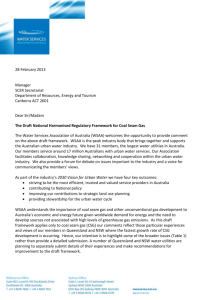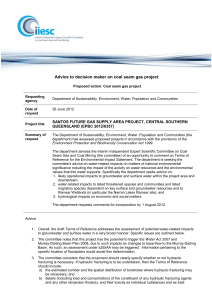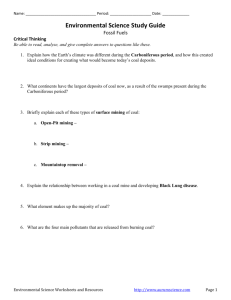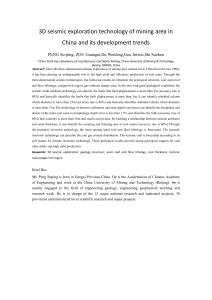how coal seam gas is extracted in NSW
advertisement
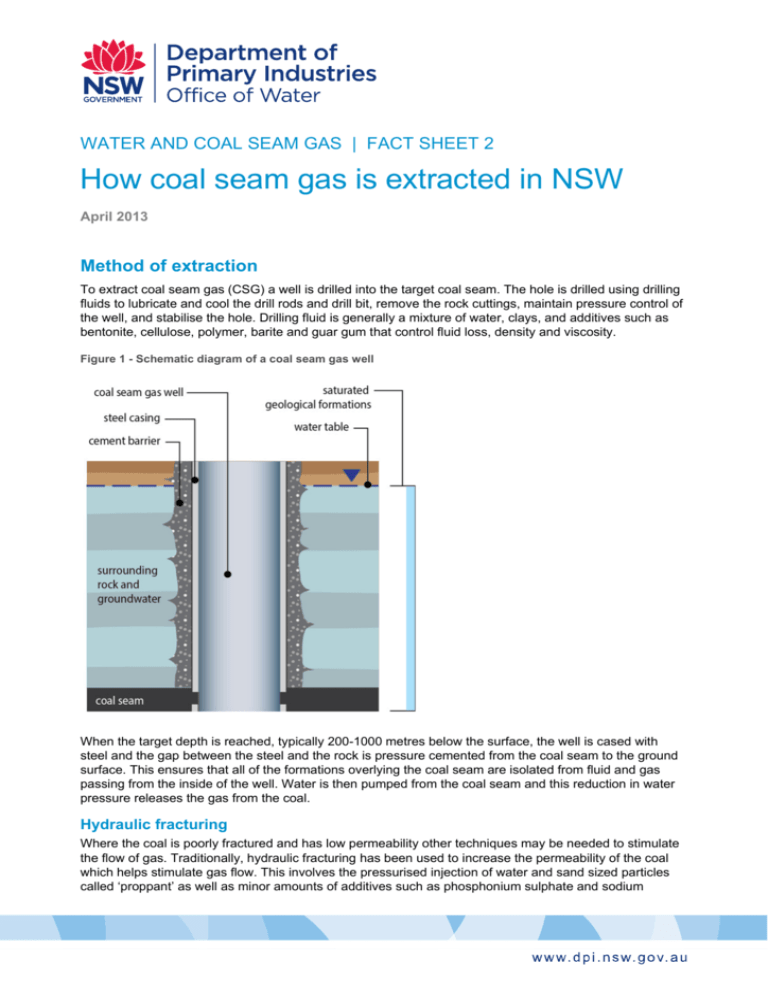
WATER AND COAL SEAM GAS | FACT SHEET 2 How coal seam gas is extracted in NSW April 2013 Method of extraction To extract coal seam gas (CSG) a well is drilled into the target coal seam. The hole is drilled using drilling fluids to lubricate and cool the drill rods and drill bit, remove the rock cuttings, maintain pressure control of the well, and stabilise the hole. Drilling fluid is generally a mixture of water, clays, and additives such as bentonite, cellulose, polymer, barite and guar gum that control fluid loss, density and viscosity. Figure 1 - Schematic diagram of a coal seam gas well When the target depth is reached, typically 200-1000 metres below the surface, the well is cased with steel and the gap between the steel and the rock is pressure cemented from the coal seam to the ground surface. This ensures that all of the formations overlying the coal seam are isolated from fluid and gas passing from the inside of the well. Water is then pumped from the coal seam and this reduction in water pressure releases the gas from the coal. Hydraulic fracturing Where the coal is poorly fractured and has low permeability other techniques may be needed to stimulate the flow of gas. Traditionally, hydraulic fracturing has been used to increase the permeability of the coal which helps stimulate gas flow. This involves the pressurised injection of water and sand sized particles called ‘proppant’ as well as minor amounts of additives such as phosphonium sulphate and sodium Water and coal seam gas - how coal seam gas is extracted in NSW hypochlorite for microbial control, acetic acid to buffer pH, acrylic copolymer as a lubricant, guar gum as a gelling agent, and polydimethyldiallylammonium chloride and tetramethyl ammonium chloride for clay management. The chemicals used in fracking fluid vary with location and depth. In NSW the use of the BTEX chemicals (benzene, toluene, ethylbenzene and xylene) in fracking fluid has been banned. The small proppant particles injected with the fracking fluid are forced into the newly created fractures in the coal. Once the pressure on the well is released, the fractures contract and the fracking fluid returns to the CSG well from where it is recovered at the surface. The proppant particles hold the fractures open allowing the gas to be released at a greater rate. Figure 2 - Fracture stimulation – flow in of fracking fluids Figure 3 - Coal seam gas well – removal of fracking fluid 2 NSW Office of Water, April 2013 Water and coal seam gas - how coal seam gas is extracted in NSW Figure 4 - Coal seam gas well – post recovery of fracking fluids Horizontal wells An alternative to hydraulic fracturing is to drill a number of horizontal wells into the coal seam. This technology is relatively new in Australia but its use is expected to increase as it allows a greater recovery of gas. Up to six horizontal wells can be drilled from one surface drill site, greatly increasing the surface area of the well exposed to the coal seam. Figure 5 – Schematic diagram of horizontal and lateral wells extending from a coal seam gas well 3 NSW Office of Water, April 2013 Water and coal seam gas - how coal seam gas is extracted in NSW Safeguards to protect water resources Two codes of practice applying to hydraulic fracturing and CSG well integrity were released by the NSW Government in 2012 to strengthen the controls applying to gas exploration and production. They can be found on the web at www.resources.nsw.gov.au, under Coal Seam Gas > Codes of Practice. The Codes of Practice establish conditions and best practice for activities such as hydraulic fracturing; the use of chemicals in fracturing fluids; and CSG well design, construction, monitoring and maintenance to ensure that these activities are carried out safely, without risk to health and without detriment to the environment. A number of practices are used in the construction and operation of CSG wells to ensure that our important water resources are protected. The loss of drilling fluid to geological formations and aquifers is minimised by using additives such as clay, polymer, gum and cellulose. These materials plug and seal pores and fractures in the rock creating a barrier between the formation and the drilling fluid in the open hole. Only approved water-based drilling fluids may be used for drilling CSG wells in NSW. Cross-contamination and leakage between aquifers is prevented by lining the CSG well with steel casing and then completely surrounding it with pressure injected cement. The cement also protects the casing from corrosion due to salty groundwater in the formations through which the well passes. Under the NSW Code of Practice for Coal Seam Gas Fracture Stimulation, an approved Fracture Stimulation Management Plan must be in place before hydraulic fracturing can occur. This Plan is to be made freely available to the public. The process of hydraulic fracturing is required to be carefully managed under the Plan to ensure that the fractures created do not extend beyond the target coal seam. This Plan must identify all of the chemicals, volumes and concentrations to be injected as part of the hydraulic fracturing activity. The Australian Petroleum Production and Exploration Association (APPEA) has published a list of chemicals used in hydraulic fracturing in Australia. Go to www.appea.com.au To ensure that no fracking fluid remains in the coal seam, the fracking fluid should be pumped from the CSG well until the background water quality of the coal seam is effectively the same as it was prior to hydraulic fracturing. The Fracture Stimulation Management Plan must identify how the water recovered from the CSG well after hydraulic fracturing is to be managed to ensure that the risks to health, safety and the environment are acceptable. What certainty is there that gas and hydraulic fracturing fluids won’t get into drinking water sources? The physical safeguards described in this factsheet ensure water sources are protected from contamination or leakage from a CSG well. The methods used to prevent drilling fluid loss, along with the rigorous standards required for steel casing and cement sealing of wells prevent contamination of groundwater by drilling mud, gas or fracking fluids. Where hydraulic fracturing has been carried out, the pumping of a gas well causes groundwater to move towards the well ensuring that any remaining fracking fluid is pulled into the well and can not migrate into surrounding geological formations or water resources. Gas wells may be pumped for 20 years or more with a much longer period again before equilibrium water levels are established. These measures protect drinking water sources from contamination. Will the water taken from coal seam gas wells impact on my access to water? The groundwater extracted by CSG production activities requires a licence to account for water taken or caused to flow from any affected groundwater or surface water source. For CSG exploration a water licence is required except where less than three megalitres per year will be taken by the activity. NSW water sharing plans (approved under the Water Management Act 2000) set a volumetric limit on the total amount of water available to be taken from a particular surface or groundwater source. If the sustainable extraction limit for a water source has not been reached the CSG operator may obtain a water 4 NSW Office of Water, April 2013 Water and coal seam gas - how coal seam gas is extracted in NSW entitlement, either through the water trading market or a controlled allocation process. If the limit has been reached then a CSG operator must obtain the appropriate water entitlement through the water market. Under some circumstances, private bores located close to a CSG extraction well may be impacted through a lowering of water levels in their vicinity. The Aquifer Interference Policy sets out minimal impact considerations for activities such as CSG extraction and the NSW Office of Water will provide advice based on these considerations to consent authorities. For more information see the Aquifer Interference Policy at www.water.nsw.gov.au More information www.resources.nsw.gov.au www.trade.nsw.gov.au/energy/gas www.water.nsw.gov.au www.appea.com.au www.nsw.gov.au/strategicregionallanduse www.csiro.au/news/coal-seam-gas © State of New South Wales through the Department of Trade and Investment, Regional Infrastructure and Services 2013. You may copy, distribute and otherwise freely deal with this publication for any purpose, provided that you attribute the NSW Department of Primary Industries as the owner. Disclaimer: The information contained in this publication is based on knowledge and understanding at the time of writing (April 2013). However, because of advances in knowledge, users are reminded of the need to ensure that information upon which they rely is up to date and to check currency of the information with the appropriate officer of the Department of Primary Industries or the user’s independent adviser. Published by the Department of Primary Industries, a division of NSW Department of Trade and Investment, Regional Infrastructure and Services. Reference number 11890 5 NSW Office of Water, April 2013


